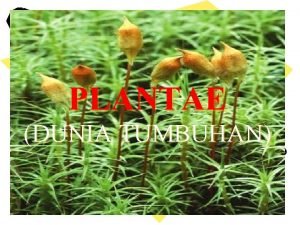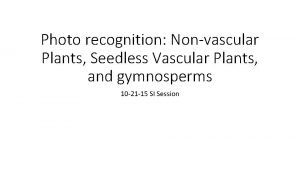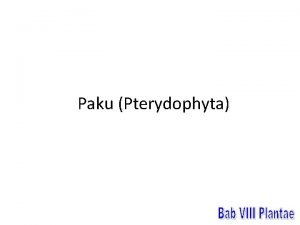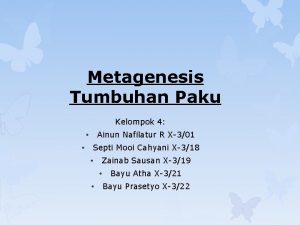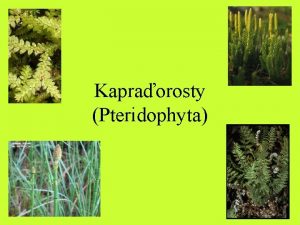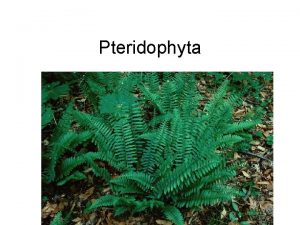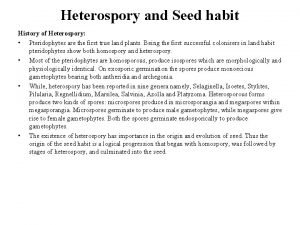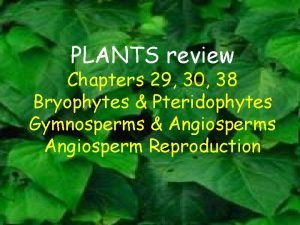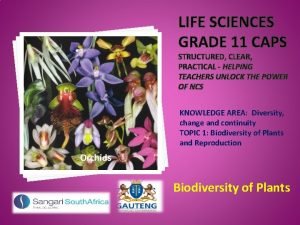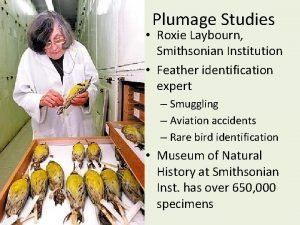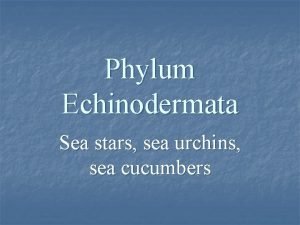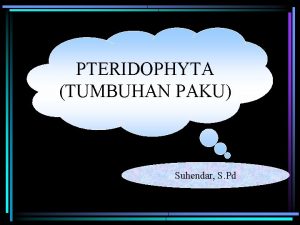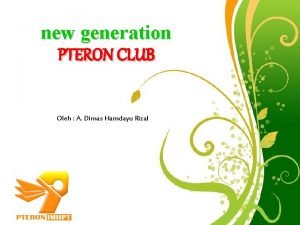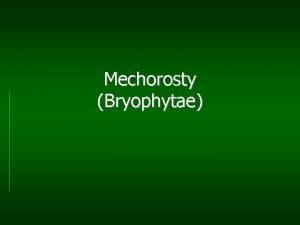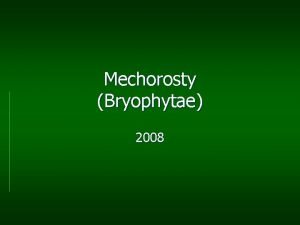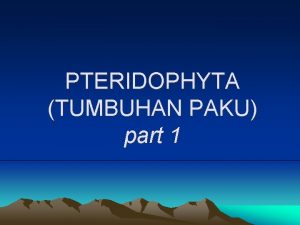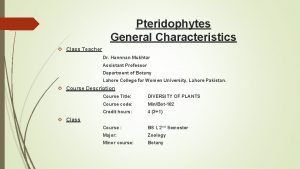PTERIDOPHYTA INTRODUCTION Pteridophytes pteron feather phyton plant i
















- Slides: 16

PTERIDOPHYTA

INTRODUCTION • Pteridophytes (pteron= feather, phyton= plant, i. e. plants with feather like leaves). • These are also known as vascular cryptogams.

HABITAT • Most of the living pteridophytes are terrestrial, growing in moist and shady places. • Some members are aquatic (Azolla, Marsilea, Salvinia) usually occurring in permanent ponds. • A few forms are xerophytic like Equisetum.

HABITAT Marsilea (Aquatic) Equisetum

PLANT BODY • They show much variation in their form, size and habit. They ranges from small annual (e. g. Azolla) to large tree-like perennials. • The main plant body is sporophytic, differentiated into root, stem and leaves. • The primary roots are ephemeral and are soon replaced by adventitious roots (which develop on rhizome). • The stem is an underground rhizome by which ferns reproduce vegetatively. Some primitive ferns have tree-like stem.

PLANT BODY • The leaves are scaly (Equisetum), small and sessile (e. g Lycopodium), or large, petiolate and compound (Ferns). • Leaves may be small microphyllous (Lycopodium) or large megaphyllous (Pteris). These are called fronds. • The root and stem have well developed vascular system, composed of xylem and phloem. The xylem is made up of tracheid and the phloem has sieve tubes only. Cambium is absent.

PLANT BODY

PLANT BODY

REPRODUCTION • Vegetative reproduction takes place by fragmentation of rhizome, adventitious buds etc. • They reproduce by spores, produced in sporangia. The sporangia are usually borne on the ventral surface of the leaf. • Sporangia occur on the surface of leaves in cluster called sori. (Sing. Sorus) and these leaves, bearing sporangia, are known as sporophylls • The sporophylls with megasporangia are called megasporophylls and with microsporangia are called microsporophylls. • Sporophylls are either unifromly distributed or are aggregated into compact cones (known as strobili) at the apex of the stem. • In aquatic forms like Azolla, Salvinia, and Marsilea the sporangia are present within specialized structure called sporocarps.

SORUS





• Psilopsida: Psilotum • Lycopsida: Lycopodium, Selaginella • Sphenopsida: Equisetum (Horse taill) • Pteropsida or Filicopsida: Pteridium, Adiantum

• Ornamental value : Because of their delicate and graceful foliage, ferns are grown as ornamental plants in gardens. • Drugs : Rhizome and petiole of Dryopteris yield an antihelminthic drug. Lycopodium is used in the treatment of rheumatism and Adiantum roots help to cure throat infection. • Food : Some are rich source of starch. • Soil binding : Pteridophytes protect the soil from erosion even along hill slopes by binding the soil. • Scouring : Equisetum stems are used in scouring (cleaning of utensils) and polishing of metals. • Biofertilisers : Azolla has a symbiotic association with nitrogenfixing cyanobacterium, Anabaena. It is inoculated to paddy fields to function as a biofertilisers.
 Phyton str
Phyton str Multiseluler eukariot
Multiseluler eukariot Muschi frunzosi
Muschi frunzosi Lychophyta
Lychophyta Jaringan pengangkut pada tumbuhan paku
Jaringan pengangkut pada tumbuhan paku Perkembangbiakan paku
Perkembangbiakan paku Plavuně stavba těla
Plavuně stavba těla Archeopteric
Archeopteric Plant introduction in plant breeding
Plant introduction in plant breeding Plant introduction in plant breeding
Plant introduction in plant breeding Plant introduction in plant breeding
Plant introduction in plant breeding Evolution of seed habit in pteridophytes
Evolution of seed habit in pteridophytes Plant reproduction
Plant reproduction Monocot leaf
Monocot leaf Paint elevation in theatre
Paint elevation in theatre Goldfinch feather identification
Goldfinch feather identification Sea cucumber dissection
Sea cucumber dissection

